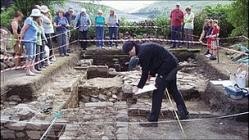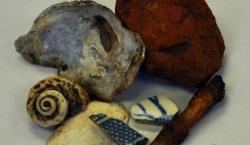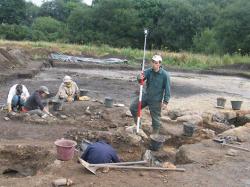- 03 AOÛT
- INDI-UNI : 
PRE-INSCRIPTION : 15 Juin – 15 Août
PRE-REGISTRATION: June 15th - August 15th
- TURQUIE – Side - archeologists found remains of an ancient bath in the west of ancient theater in Antalya's Side hamlet. the bath dated back to Late Ancient Age and Early Byzantine Age. Side is an ancient Luvi city in Anatolia in the region of Pamphylia (today Antalya). Pamphylia belonged to the ancient Hittite empire. The main towns were Estwediiys (later known as Aspendos) and Side. Most archaeological remains that can be visited today in towns like Aspendos and Side, date back to Roman times. The Theatre lies on the narrowest part of the peninsula and the central side of the Side. Although the theatre plan has a Hellenistic tradition, the building has a Roman architectural tradition in structure. The Theatre of Side is a unique example in this way of structure. Skenae Frons has a three storey colonnade facade. The facade decoration has a characteristic of Antonine Period. In the first storey can be seen the Dionysos Friese.
http://www.worldbulletin.net/?aType=haber&ArticleID=76693
- FRANCE – Marsal - Dans le Saulnois, un important complexe a en effet été découvert. Il est constitué de plusieurs sites de production du sel datant de l'Âge du Fer. La structure interne des ateliers de sauniers celtiques et gaulois -dont certains s'étendent sur plusieurs dizaines d'hectares entre les villages de Marsal et Salonnes- se dévoile peu à peu. Réel atout économique, le sel a fait l'objet d'une production intensive entre le Ve et le Ier siècle avant notre ère, dans la région rhénane et sur le littoral atlantique. Il était indispensable non seulement pour les hommes et les animaux, mais également pour la conservation des denrées alimentaires telles que la viande, le poisson ou encore le fromage. Avec le développement de l'agriculture, la nécessité de conserver les surplus a renforcé encore la demande en sel. Le site de la vallée de la Seille a été l'un des premiers sites gaulois de production de sel fouillé et ce, dès les années 1970. De nouvelles fouilles, actuellement en cours à Marsal, fournissent des résultats inédits sur l'organisation du travail et l'exploitation des ressources naturelles au premier âge du fer. Dans la vallée de la Seille, la présence des briquetages a profondément marqué le paysage. La présence du sel gemme à même la surface du sol explique cette exploitation "quasi-industrielle". Le principe du "briquetage" est basé sur une exploitation indirecte de l'eau de mer ou, comme en Lorraine, de l'eau de sources et de rivières salées. L'eau salée est versée dans les moules d'argile puis chauffée afin d'évacuer l'eau et de conserver le sel. Après utilisation, ces moules sont détruits. Les amas de tessons ont donné le terme de "briquetage" connu à ce jour.
http://www.newspress.fr/Communique_FR_243870_653.aspx
- AZERBAIDJAN – Fuzuli - Archaeological excavations have been carried out in the Sheikh Baba sanctuary in Fuzuli District since early July. Sheikh Baba sanctuary is one of the greatest architectural monuments of Azerbaijan. Mausoleum and a dilapidated minaret of the sanctuary have survived to this day. The mausoleum was built in 1373-1374 in honor of Sufi sheikh Ali Baba Yaqub by architect Majiddin. The archeological excavations that cover an area of 1,100 square meters have unearthed ruins of public buildings of the XIV century and underground tomb in an area of 576 square meters so far. Head of the expedition Khagani Almammadov said six stone coffins relating to the XIV century have been found here. Archaeologists have not met this form of burial in Azerbaijan so far. These stone coffins have been constructed of special bricks and stones adorned with ornaments. There is no doubt that medieval warriors have been buried there. A skeleton without the skull have been discovered in one of the tombs while skeleton and arrows have been discovered in the other. Along with the archeological excavations, restoration and conservation works are also planned in this area.
- ROYAUME UNI –  Low Borrowbridge Farm - A group of amateur archaeologists has been breaking new ground on a former Roman fort in Cumbria. The Lunesdale archaeology group has been digging at Low Borrowbridge Farm, next to the M6 in the Tebay gorge. So far they have found walls, the remains of an ancient central heating system and a giant arrowhead from a artillery ballista. The week-long dig has also raised new questions about a building that had been thought to be a bath house. A previous dig took place on the site in 1883 by the Cumberland and Westmorland Antiquarian and Archaeological Society. During this survey a small amount of flooring was discovered. This led to the theory that the site contained a bath house. Joseph Jackson from the Vindolanda Trust, who has been watching progress, said: "In the past the site has been designated as a potential bath house, but we're still in doubt of that."It is certainly a building of high status. We can tell that from the walls and the concrete that we are getting."
Low Borrowbridge Farm - A group of amateur archaeologists has been breaking new ground on a former Roman fort in Cumbria. The Lunesdale archaeology group has been digging at Low Borrowbridge Farm, next to the M6 in the Tebay gorge. So far they have found walls, the remains of an ancient central heating system and a giant arrowhead from a artillery ballista. The week-long dig has also raised new questions about a building that had been thought to be a bath house. A previous dig took place on the site in 1883 by the Cumberland and Westmorland Antiquarian and Archaeological Society. During this survey a small amount of flooring was discovered. This led to the theory that the site contained a bath house. Joseph Jackson from the Vindolanda Trust, who has been watching progress, said: "In the past the site has been designated as a potential bath house, but we're still in doubt of that."It is certainly a building of high status. We can tell that from the walls and the concrete that we are getting."
http://www.bbc.co.uk/news/uk-england-cumbria-14362255
- ROYAUME UNI – Kempsey - Another 16 graves have been found in a Worcestershire village where new flood defences are being built. The 16 are in addition to the 12 uncovered in Kempsey last week next to St James Church. It is thought that some of the skeletons could date back as early as 500 AD. Tom Vaughan from Worcestershire Archaeology Service said their location just outside the church's graveyard alters the history of the area. "We thought the graveyard boundary was static and had remained where it was since the church was first built but this clearly shows it was much larger," he said. "It indicates Kempsey was a lot more important than the smaller village we have now." He said it backed up evidence there was a Minster church in the area during the Anglo Saxon period and also a bishop's palace. Experts hope results from analysing the skeletons will reveal more about the people's quality of life, how they died, how old they were and if any of them were related.
http://www.bbc.co.uk/news/uk-england-hereford-worcester-14385779
- NOUVELLE ZELANDE –  Mangungu - A drawing done 173 years ago of one of New Zealand's earliest mission settlements near Horeke in the Hokianga has helped archaeologists piece together a slice of Northland's history. The accuracy of the drawing done by Emma Hobbs – daughter of Methodist missionary John Hobbs – showing the Mangungu Mission House and other surrounding buildings has been confirmed by archaeological monitoring of the site. "Information we've picked up from the geomagnetic survey shows remnants of building platforms in much the same area shown in the painting, which confirms what we've suspected for a long time – that this was the original site of the settlement, including the mission house," Dr Hans-Dieter Bader of Archaeology Solutions says. Originally built on site in 1838-1839, the mission house was later relocated to Auckland where it was used as a parsonage for over a century. Using a non-invasive geomagnetic survey of the area, archaeologists were able to minimise the impact of digging a cable trench on any archaeological material present. Amazingly a few objects were unearthed as a result of the trench being dug, including a small piece of brick, a forged iron nail, some ceramic shards and some shells from what would have been a rubbish dump. The presence of oyster and pipi shells in the same midden raises some intriguing questions, Dr Bader says. "It makes me curious whether the missionaries followed aspects of the local Maori diet." Although only a few objects were found, according to Dr Bader, thy can provide a better understanding of how Maori and missionaries lived together.
Mangungu - A drawing done 173 years ago of one of New Zealand's earliest mission settlements near Horeke in the Hokianga has helped archaeologists piece together a slice of Northland's history. The accuracy of the drawing done by Emma Hobbs – daughter of Methodist missionary John Hobbs – showing the Mangungu Mission House and other surrounding buildings has been confirmed by archaeological monitoring of the site. "Information we've picked up from the geomagnetic survey shows remnants of building platforms in much the same area shown in the painting, which confirms what we've suspected for a long time – that this was the original site of the settlement, including the mission house," Dr Hans-Dieter Bader of Archaeology Solutions says. Originally built on site in 1838-1839, the mission house was later relocated to Auckland where it was used as a parsonage for over a century. Using a non-invasive geomagnetic survey of the area, archaeologists were able to minimise the impact of digging a cable trench on any archaeological material present. Amazingly a few objects were unearthed as a result of the trench being dug, including a small piece of brick, a forged iron nail, some ceramic shards and some shells from what would have been a rubbish dump. The presence of oyster and pipi shells in the same midden raises some intriguing questions, Dr Bader says. "It makes me curious whether the missionaries followed aspects of the local Maori diet." Although only a few objects were found, according to Dr Bader, thy can provide a better understanding of how Maori and missionaries lived together.
http://www.stuff.co.nz/auckland/local-news/northland/whangarei-leader/5380732/History-unearthed-in-drawing
- FRANCE –  Plesder - Malgré les conditions météorologiques défavorables, l'équipe de l'archéologue Jean-Bernard Vivet a avancé depuis quelques jours dans ses fouilles de l'atelier métallurgique gallo-romain au lieu-dit de la Pilleverte. D'après les recherches et observations de l'archéologue, le fourneau serait recouvert d'un grand appentis semi-ouvert, d'au moins seize mètres de long, et constitué de bois et de tuiles. « Nous avons la confirmation qu'il s'agit bien d'un atelier avec une production de métal assez importante. Nous avons trouvé encore de nombreux déchets métallurgiques, carbonés et scories... » Malgré l'avancement des recherches, des pans d'ombres demeurent : « Nous nous posons encore beaucoup d'interrogations sur cette production. À quel point ce métal était-il affiné et transformé ? Qui gérait la structure ? Qui étaient les destinataires de cette production ? » Néanmoins, les récentes découvertes ont permis de lever le doute sur certaines choses : « Sur les conditions de travail, nous avons retrouvé, dans le périmètre de l'atelier, quelques céramiques et poteries, preuve que les ouvriers mangeaient sur place. Par contre, il n'y a pas d'implantation humaine à proximité de cet atelier. »
Plesder - Malgré les conditions météorologiques défavorables, l'équipe de l'archéologue Jean-Bernard Vivet a avancé depuis quelques jours dans ses fouilles de l'atelier métallurgique gallo-romain au lieu-dit de la Pilleverte. D'après les recherches et observations de l'archéologue, le fourneau serait recouvert d'un grand appentis semi-ouvert, d'au moins seize mètres de long, et constitué de bois et de tuiles. « Nous avons la confirmation qu'il s'agit bien d'un atelier avec une production de métal assez importante. Nous avons trouvé encore de nombreux déchets métallurgiques, carbonés et scories... » Malgré l'avancement des recherches, des pans d'ombres demeurent : « Nous nous posons encore beaucoup d'interrogations sur cette production. À quel point ce métal était-il affiné et transformé ? Qui gérait la structure ? Qui étaient les destinataires de cette production ? » Néanmoins, les récentes découvertes ont permis de lever le doute sur certaines choses : « Sur les conditions de travail, nous avons retrouvé, dans le périmètre de l'atelier, quelques céramiques et poteries, preuve que les ouvriers mangeaient sur place. Par contre, il n'y a pas d'implantation humaine à proximité de cet atelier. »
http://www.ouest-france.fr/actu/actuLocale_-Les-fouilles-archeologiques-avancent-a-la-Pilleverte-_22035-avd-20110725-60960096_actuLocale.Htm